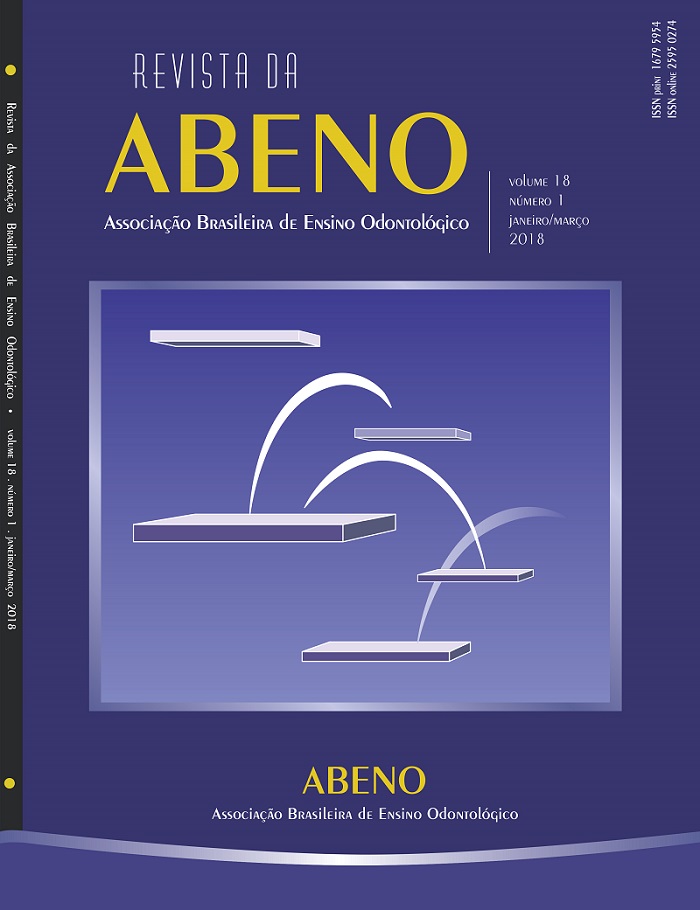Teaching tools in dental carving: models, virtual resources, and interactivity
DOI:
https://doi.org/10.30979/rev.abeno.v18i1.478Keywords:
Dental Education, Anatomy, Sculpture.Abstract
This study aimed to access students’ perception evaluating the usefulness of the Three-Stages Sculpture Geometric Technique and auxiliary tools to learn dental anatomy and the impact of this on their grades. Wax models and resources in the virtual environment, such as demonstration videos of carving technique, classes’ files, online tests, and forums were offered to two groups of students. Students’ perception was collected using a questionnaire. A comparison between their grades and the virtual resources’ frequency use was made; between the grades of the two groups and between theirs and those obtained by a third group, which did not use these tools. Students rated favorably the technique, the wax models, the videos and the other resources offered in a virtual environment. The models were considered more efficient as an aid to learning than were the videos, with a significant difference. There was no relation between the frequency to the videos and also to the other virtual resources offered, and the results in grades of the students of Group A and B. The mean grade of both Groups did not differ. There was a positive difference on final grade of Group B students who visited all the virtual resources offered compared with those that didn’t. The applied carving technique provided and facilitated learning of dental anatomy and the aid given by the models was more efficient. Interactivity seemed expendable to improve results in grades.
Downloads
References
Abu ER, Ewan K, Foley J, Oweys Y, Jayasinghe J. Self-directed study and carving tooth models for learning tooth morphology: Perceptions of students at the University of Aberdeen, Scotland. J Dent Educ. 2013; 77(9):1147-53.
Buchaim RL, Andreo JC, Rodrigues AC, Gonçalves JBO, Daré LR, Rosa Junior GM, et al. Multidisciplinary approach in the teaching of dental sculpture and anatomy. Int J Morph. 2014; 32(2):399-403.
Kilistoff AJ, Mackenzie L, D'Eon M, Trinder K. Efficacy of a step-by-step carving technique for dental students. J Dent Educ. 2013; 77(1):63-7.
Mitov G, Dillschneider T, Abed MR, Hohemberg G, Pospiech P. Introducing and evaluating MorphoDent, a Web-based learning program in dental morphology. J Dent Educ. 2010; 74(10):1133-9.
Obrez A, Briggs C, Buckman J, Goldstein L, Lamb C, Knight WG. Teaching clinically relevant dental anatomy in the dental curriculum: description and assessment of an innovative module. J Dent Educ. 2011; 75 (6):797-804.
Aspden L, Helm P. Making the connection in a blended learning environment. EMT 2004;41(3):245-252.
Delialioglu O. 2007. Investigation of source of motivation in a hybrid course. [Acesso em 8 mai. 2016]. Disponível em: http://www. eric.ed.gov/ERICDocs/data/ericdocs2sql/content_storage_01/0000019b/80/1b/a7/1b.pdf
Seluakumaran K, Jusof FF, Ismail R, Husain R. Integrating an open-source course management system (Moodle) into the teaching of a first-year medical physiology course: a case study. Adv Physiol Educ. 2011; 35(4):369-77.
Dougiamas M, Taylor PC. 2003. Moodle: using learning communities to create an Opens Source Management System. [Acesso em 23 out. 2015]. Disponível em: https:// dougiamas.com/archives/edmedia2003/
Moodle. 2014. Moodle organization. [Acesso em 30 abr. 2015]. Disponível em: www.moodle.org
Picosse M. Anatomia Dentária. 4th Ed. São Paulo: Sarvier, 1983.
Nelson SJ, Ash MM. Wheeller’s Dental Anatomy, Physiology and Occlusion. 9th ed. St Louis: Saunders Elsevier; 2010.
Shott S. Statistics for health professional. London: W. B. Saunders Company, 1990.
Conway J. Educational technology’s effects on models of instructions. [Acesso em 5 abr. 2015]. Disponível em: http://www.irfaner dogan.com/egitim/Educational%20Technology.htm
Horst J, Clark MD, Lee AH. Observation, assisting, apprenticeship: cycles of visual and kinesthetic learning in dental education. J Dent Educ. 2009; 73(8):919-33.
Lange P, Suwardy T, Mavondo F. Integrating a virtual learning environment into an introductory accounting course: determinants of students’ motivation. Accounting Education. 2003; 12(1):1-14.
Cantín M, Muñoz M, Olate S. Generation of 3D tooth models based on three-dimensional scanning to study the morphology of permanent teeth. Int J Morphol. 2015; 33(2): 782-7.
Gossnhelmer AN, Ben T, carneiro MLF, Castro M. Impact of distance education on academic performance in pharmaceutical care course. PLoS One. 2017; 12(4):1-11.
Dantas AM, Kemm RE. A blended approach to active learning in a physiology laboratory-based subject facilitated by an e-learning component. Adv Physiol Educ. 2008; 32(1): 65-75.
Al-Thobity AM, Farooq I, Khan SQ. Effect of software facilitated teaching on final grades of dental students in a dental morphology course. Saudi Med J. 2017; 38(2):192-5.
Wright EF, Hendricson WD. Evaluation of a 3-D interactive tooth atlas by dental students in Dental Anatomy and Endodontics courses. J Dent Educ. 2010; 74(2):110-22.
Dobson JL. The use of formative online quizzes to enhance class preparation and scores on summative exams. Adv Physiol Educ. 2008; 32(4): 297-302.
Kibble J. Use of unsupervised online quizzes as formative assessment in a medical physiology course: effects of incentives on student participation and performance. Adv Physiol Educ. 2007; 31(3):253-60.
Downloads
Published
How to Cite
Issue
Section
License
Autores que publicam nesta revista concordam com os seguintes termos:
a) Autores mantém os direitos autorais e concedem à revista o direito de primeira publicação, com o trabalho simultaneamente licenciado sob a Licença Creative Commons Attribution que permite o compartilhamento do trabalho com reconhecimento da autoria e publicação inicial nesta revista.
b) Autores têm autorização para assumir contratos adicionais separadamente, para distribuição não-exclusiva da versão do trabalho publicada nesta revista (ex.: publicar em repositório institucional ou como capítulo de livro), com reconhecimento de autoria e publicação inicial nesta revista.
c) Autores têm permissão e são estimulados a publicar e distribuir seu trabalho online (ex.: em repositórios institucionais ou na sua página pessoal) a qualquer ponto antes ou durante o processo editorial, já que isso pode gerar alterações produtivas, bem como aumentar o impacto e a citação do trabalho publicado (Veja O Efeito do Acesso Livre).






